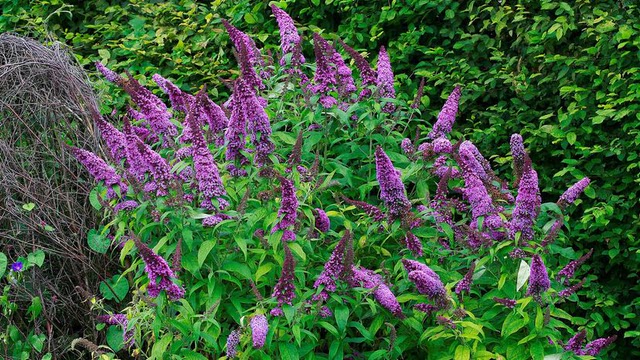Lawn & Garden

Butterfly bushes, scientifically known as Buddleja davidii, are a great option for those looking for a long-blooming shrub that comes in a variety of colors. Not only do they add color to your garden, but they also provide food for both butterflies and hummingbirds. Here are five reasons why you should consider growing a butterfly bush.
1. Attracts Butterflies and Pollinators
Butterfly bushes are known for attracting butterflies and other pollinators to your garden. The flowers are high in nectar, which is why they draw in a large number of butterflies. However, they do not support butterfly reproduction and lifecycle as caterpillars do not feed on them. Instead, they only provide nectar to adult butterflies.
2. Easy to Care For
Butterfly bushes are considered drought-tolerant, but they respond well to good watering practices. To keep the plant blooming, it is recommended to remove old bloom spikes that have finished blooming and are beginning to go to seed. They bloom most of the summer and overwinter, making them a great perennial option. They are hardy to Zone 5 and can be grown in a variety of soils.
3. Variety of Colors and Sizes
Butterfly bushes come in a wide range of colors and sizes. They can be large shrubs or smaller dwarf shrubs that can stand alone or be incorporated into flower beds. The blooms are mostly shades of blue, purple, and lavender, but they also come in white, pink, and yellow.

A monarch butterfly takes a sip of nectar from the blossom of a butterfly bush.
4. Hardy and Resilient
Butterfly bushes are seemingly impervious to challenging environments such as urban settings and can withstand pollution, drought stress, and insect pressure.
5. Prolific Bloomers
Butterfly bushes are some of the longest-blooming shrubs you can find and bloom continuously through fall. They are a great addition to any garden looking for a pop of color and the added benefit of attracting pollinators.
Overall, butterfly bushes are a great addition to any garden looking for a low-maintenance, long-blooming shrub that attracts pollinators.
4. More Sun Equals More Flowers
According to Collins, butterfly bushes thrive in full sun or as much sun as possible. They cannot tolerate full shade and require well-drained soil. Avoid planting butterfly bushes in boggy areas with shade. When transplanting the plant, make sure the roots are not planted deeper than they were in the corresponding pot to prevent overwatering. Wasser suggests watering the plant when the soil is dry and pruning canes to a few inches above the ground in late winter. The canes that grow will bear flowers. In addition, fertilize the butterfly bushes with a natural and organic granular fertilizer in early spring and early fall.
5. Ideal for Flower Arrangements
Wasser advises cutting butterfly bush flowers in the morning when they are freshest. The flowers can be cut at any time while the plant is in bloom. As soon as the flowers are cut, place them in water to preserve their freshness.
Now That’s Interesting
The butterfly bush can be invasive and may out-compete other plants, making it a noxious weed. Wasser warns that the plant is on invasive plant watch lists or banned in some states. To avoid such issues, breeders are working on seedless and non-invasive varieties. Dr. Dennis Werner of North Carolina State University, for example, collaborates with Proven Winners to introduce non-invasive and seedless varieties such as the “Miss” and Lo & Behold series.
FAQ
1. What is a Butterfly Bush?
A Butterfly Bush is a deciduous shrub that produces large, fragrant flowers in a variety of colors. It is named after its ability to attract butterflies and other pollinators, making it a popular choice for gardens and landscapes. The plant can grow up to 10 feet tall and wide, but with regular pruning, it can be kept to a more manageable size.
2. What are the benefits of growing a Butterfly Bush?
Aside from its beautiful flowers, a Butterfly Bush provides many benefits to your garden. As mentioned, it attracts pollinators which can help improve the health of your garden. Additionally, it can provide shade and shelter for small animals and birds. The plant is also relatively low maintenance, making it a great option for those who want a beautiful garden without a lot of upkeep.
3. When should I plant a Butterfly Bush?
The best time to plant a Butterfly Bush is in the spring or fall. This will give the plant time to establish its roots before the hot summer months or cold winter months. It is important to choose a location that gets plenty of sunlight and has well-draining soil.
4. How do I care for a Butterfly Bush?
A Butterfly Bush requires little maintenance, but there are a few things you can do to ensure it stays healthy and beautiful. Regular pruning will help keep the plant to a manageable size and encourage new growth. It is also important to water the plant regularly, especially during hot, dry periods. Fertilizing the plant once a year with a balanced fertilizer can also help promote healthy growth.
5. What are some popular varieties of Butterfly Bush?
There are many varieties of Butterfly Bush to choose from, each with their own unique characteristics. Some popular varieties include the Black Knight (deep purple flowers), the White Profusion (white flowers), and the Nanho Blue (blue flowers). It is important to choose a variety that will thrive in your specific climate and growing conditions.

Brody is a skilled craftsman and gardening expert. From renovating living spaces to cultivating lush gardens, Brody’s knowledge and passion shine through, inspiring readers to embark on their own home improvement and gardening journeys with confidence.






Leave a Reply